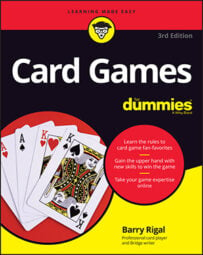In a game of Hearts, the player on the dealer’s left starts by playing whatever non-scoring card he likes. In Hearts, the cards rank in regular fashion, from ace to 2, with the ace being high. You must follow suit (play a card in the suit led) if you can, and if you can’t, you can play whatever you want.
Each player throws in a card, and whoever plays the highest card in the suit led wins the trick. You stack the tricks you take in front of you to facilitate the scoring at the end of the hand and you leave the penalty cards you unwillingly garner face-up in front of you.
After the opening lead, a club lead is compulsory in most variations of the game. Otherwise, you have only one other vital restriction: Unless the heart suit has been broken — that is, a player discards a heart on a trick — you can’t lead a heart unless it’s the only suit you have left in your hand.
If you have the Queen of Spades, you want to get rid of it as quickly as possible, or you may want to pass it on to the opponent who’s winning the game, to the closest pursuer behind you, or even to someone whose attitude you don’t like! Whichever approach you choose with respect to playing the Queen of Spades is fine. It is up to you what you do, unless you play that you have no choice, and must pass on the Queen of Spades as quickly as possible.
As a general rule, the right approach in Hearts is judicious self-preservation first, spite and malice next. Throw the dangerous cards in your hand away first before painting tricks that your opponents win. If you never score any points, you’re pretty sure to win, so try for that goal first and wait to upset your opponents until you feel safe.
Try to remember the cards in the suits that matter to you because your hand suggests they may be dangerous. You may not have to remember the diamonds if you have only the Q, 8, and 3 (you can be fairly sure your 3 won’t win the third round), but with the Q, 8, 5, and 4, you need to keep a count of the suit and note if the 3 and 2 have put in an appearance. Otherwise, the third and fourth round of the suit may be more painful than you expect!
Don’t try to count the hearts — players normally leave them visible on the table in front of you within taken tricks. Focus on the spades and whichever of the diamonds or clubs look worrying to you. Start by counting the number of times the suit has been led (assuming each time that four cards were played, that is unless you have noted someone show out). Far trickier is remembering to add one to your count of the cards played in a suit every time a player discards in that specific suit. After you feel confident you can keep count of the suit, try to expand your record keeping to remembering which small cards are still missing.
Say you have the Q, 8, 5, and 4 of diamonds. If the King of diamonds is led, you throw your Queen of Diamonds, and the Jack and 9 of Diamonds show up. On the next diamond trick, your 8 comes in under the Ace of Diamonds, and the 10 and 3 of Diamonds put in appearances. When you see the 7 of Diamonds discarded, you know that two rounds of diamonds represent eight cards in the suit. The discard of the 7 of Diamonds makes nine, and your two remaining diamonds make eleven. Two diamonds are still out — one being the 2, which you’re watching for, the other the 6 (which is higher one than your 5). The point: If one player has both diamonds, you might lose the next trick, but you would then be able to lead your last diamond and know the player with the diamonds will take the trick. Of course, it may be too late — someone may have passed you the Queen of Spades already! And note that the player with the 6 and 2 of Diamonds might win the first diamond trick with the 6 and lead back the 2, letting you win the second diamond trick not the first.
If the missing diamonds are split, you can lead a diamond now and leave yourself with a safe card in diamonds. Playing a diamond yourself, as soon as you can, may be a better strategy than letting someone else discard that 6 of Diamonds.
Leave yourself with low cards in each suit for the later tricks — the third and even the second round of a suit. Doing so allows you to lose tricks late in the game when everyone wants to unload their hearts and the Queen of Spades. Avoid playing on your safe suits (the ones where you have 2s and 3s that won’t win tricks) until the end of the hand, but be aware that your opponents want to do the same thing.

